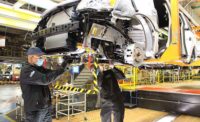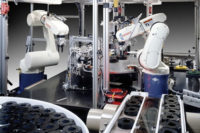FRANKFURT—Preliminary data by the International Federation of Robotics shows a 19 percent sales increase of industrial robots to China in 2020, including during the COVID-19 pandemic. Overall, nearly 167,000 industrial robots were delivered there last year.
"In China, where the coronavirus lockdown came into force first, the robotics industry started to recover already in 2020,” says Milton Guerry, President of the International Federation of Robotics. “The outlook for the robotics industry is optimistic.”
Sales from foreign suppliers were up by 24 percent, to 123,000 robots, with Japanese suppliers accounting for the dominant share. Domestic suppliers provided another 44,000 units to their home market, which is an increase of 8 percent compared to 2019.
However, overall global robot installations in 2020 were down 2 percent, particularly due to the impact of COVID-19 Still, the decline in sales was more moderate than expected.
The Organisation for Economic Cooperation and Development projects global GDP growth to be 5.5 percent in 2021 and 4 percent in 2022. Nevertheless, the situation is mixed in different countries.
The order intakes of the robotics industry 2021 give reason to expect strong growth in North America and Europe. Order books in the US for example are filling up fast. In Germany, the forecast for the current year shows a strong recovery and signifies a positive turning point for the industry. Even better sales figures will be achievable if the current supply bottlenecks for key components can be quickly overcome.
The global path to climate neutrality is generating new business. In order to achieve the ambitious climate targets, economies have started to scale renewable energies and environmental technologies to unprecedented dimensions. Robotics and automation enable companies of all sizes to produce the components needed; for example, fuel cells for hydrogen-powered cars or batteries in the transport sector and solar panels in the energy sector. The new generation of easy-to-use robotics helps to optimize performance in the production process and move manufacturing closer to regional markets at competitive cost.
“Robotics [can] quickly adapt production and respond to changes in demand, as well as smaller batch sizes,” says Guerry. “The benefits of increased productivity safeguards jobs by keeping companies competitive.”



